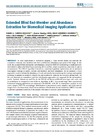Please use this identifier to cite or link to this item:
https://accedacris.ulpgc.es/handle/10553/69248
| Title: | Extended Blind End-Member and Abundance Extraction for Biomedical Imaging Applications | Authors: | Campos-Delgado, Daniel U. Gutierrez-Navarro, Omar Rico-Jimenez, Jose J. Duran-Sierra, Elvis Fabelo Gómez, Himar Antonio Ortega Sarmiento, Samuel Marrero Callicó, Gustavo Iván Jo, Javier A. |
UNESCO Clasification: | 3314 Tecnología médica | Keywords: | Blind linear unmixing Constrained optimization Fluorescence lifetime imaging microscopy Hyperspectral imaging Optical coherence tomography |
Issue Date: | 2019 | Project: | Identificación Hiperespectral de Tumores Cerebrales (Ithaca) | Journal: | IEEE Access | Abstract: | In some applications of biomedical imaging, a linear mixture model can represent the constitutive elements (end-members) and their contributions (abundances) per pixel of the image. In this work, the extended blind end-member and abundance extraction (EBEAE) methodology is mathematically formulated to address the blind linear unmixing (BLU) problem subject to positivity constraints in optical measurements. The EBEAE algorithm is based on a constrained quadratic optimization and an alternated least-squares strategy to jointly estimate end-members and their abundances. In our proposal, a local approach is used to estimate the abundances of each end-member by maximizing their entropy, and a global technique is adopted to iteratively identify the end-members by reducing the similarity among them. All the cost functions are normalized, and four initialization approaches are suggested for the end-members matrix. Synthetic datasets are used first for the EBEAE validation at different noise types and levels, and its performance is compared to state-of-the-art algorithms in BLU. In a second stage, three experimental biomedical imaging applications are addressed with EBEAE: M-FLIM for chemometric analysis in oral cavity samples, OCT for macrophages identification in post-mortem artery samples, and hyper-spectral images for in-vivo brain tissue classification and tumor identification. In our evaluations, EBEAE was able to provide a quantitative analysis of the samples with none or minimal a priori information. | URI: | https://accedacris.ulpgc.es/handle/10553/69248 | ISSN: | 2169-3536 | DOI: | 10.1109/ACCESS.2019.2958985 | Source: | IEEE Access [ISSN 2169-3536], v. 7, p. 178539 - 178552 |
| Appears in Collections: | Artículos |
SCOPUSTM
Citations
25
checked on Mar 30, 2025
WEB OF SCIENCETM
Citations
14
checked on Mar 30, 2025
Page view(s)
73
checked on Dec 30, 2023
Download(s)
128
checked on Dec 30, 2023
Google ScholarTM
Check
Altmetric
Share
Export metadata
Items in accedaCRIS are protected by copyright, with all rights reserved, unless otherwise indicated.
